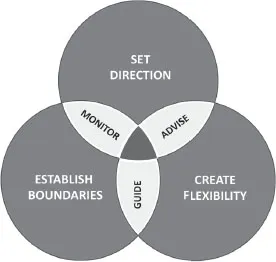![]()
![]()
1
Building trust to get around the hand
The role of an adviser
Everyone is an adviser. Even if you are the CEO or the Chair of the Board, you are an adviser — to each other, and to other members of the executive team and board. As an adviser you seek to influence key decisions. The people we take advice from most readily are those we most trust. To be clear, trust is contextual. I trust my mum, but I don’t rely on her advice when it comes to the internet. In the boardroom, a CEO and Chair who trust each other are more likely to get more done more quickly. And as an adviser to the board, trust is your most valuable asset. Hence the original consultant’s bible on influencing, David Maister’s The Trusted Advisor.
In this chapter I explore the challenge of becoming a trusted adviser through the lens of an internal adviser. If you are not an internal adviser, you will soon appreciate that there is much to be learned from the best of these skilled professionals. So don’t skip this section — read on while thinking about when and how you give advice in your own role. You may be surprised by how often you do so!
First let me explain the role of an internal adviser in organisations.
Figure 1.1 captures the essence of an organisation. Based on the organisation’s purpose, the leadership will set the direction, giving management the flexibility to create strategies that respond to the complexity of the modern world. Some boundaries are established based on an assessment of overall organisational capability. Your advice on where and how these boundaries should be set and your implementation of them determines whether you are creating red tape or top notch blue ribbon service.
| Figure 1.1: Essence of an organisation |
When the leadership team sets the organisation’s direction, it can be very specific: ‘We are going to be the nation’s leading manufacturer of quality beds, with market share in excess of 40 per cent by 2020.’ Or it can be much less specific: ‘Our goal is to disrupt the bed manufacturing industry in this country through technology.’
When developing strategy, management assesses the organisation’s capacity to progress in the direction set while at the same time designing a combination of execution and capability-building strategies.
Organisations usually — or they should if you want blue ribbon — define a range of boundaries. Some are hard boundaries, any breach of which is serious. Some are cushioned: warning signals are provided along the way so management can reconsider their approach according to circumstances. And some are flexible, recognising that speed is important so long as little harm can result.
My favourite analogy here is a naval one. Without getting into technical language, the Admiral of the Fleet may provide instructions to a ship’s captain along these lines: ‘Captain, I want you off the coast of Okinawa by the end of the month. I know the design capability of your ship, though I don’t know the current readiness of the ship or of your crew, and of course I can’t predict the weather. So I’ll leave it to you how you do it. But do not enter the disputed waters of the South China Sea. We don’t want a diplomatic incident on our hands!’
Figure 1.2 depicts the essence of the internal adviser’s role, which can be summarised as to advise, guide and monitor. They advise leadership on the direction the organisation should go, based on their specific expertise. For example, an adviser from finance may provide advice based on balance sheet strength, whereas a human resources adviser will have a different view on organisational capability for leadership to consider. And so on.
Drawing on their specific expertise, advisers also propose strategies for management to employ. An adviser from procurement might share information on the strength or otherwise of a supplier market. A compliance adviser might spell out the costs of complying with relevant legislation in pursuing a strategy proposed by the management team.
| Figure 1.2: Essence of internal advising |
Advisers also offer counsel on the boundaries that need to be established in organisations, from travel and sick leave policies to critical areas such as safety or consumer protection laws, and everything in between.
While advisers guide people in meetings and in one-on-one conversations, they also contribute through the design and implementation of policies, frameworks and processes. In finance, for example, delegation and budgetary frameworks are established, along with processes for reporting on budgets and applying for budget variations. These are all critical enabling systems for organisations and must be blue ribbon and not red tape for your organisation to be as agile as you want it to be.
Advisers monitor the boundaries they have established. Monitoring occurs through a variety of mechanisms, from online, real-time oversight to formal audits.
The critical question for an internal adviser is what happens when a manager, a staff member or a whole business unit breaches one or more of these boundaries? Depending on whether it is a flexible, cushioned or hard boundary, you may be able to work together with the business unit in a cordial and collaborative way to help move things back within acceptable boundaries. It could be as simple as recasting a budget forecast and working out which line items need to be addressed over time to bring the budget back under control.
Sometimes, though, you will need to report a situation to the leadership team. It could be a sudden, unexpected breach that you are obligated to report, or it could be that despite your best efforts, the person or business unit has failed to heed your advice and it is time to escalate the issue. In either case this is a problem for you, because it likely creates conflict and affects the trust the person or business unit has in you.
The trust factor
If your organisation is a well-oiled machine, then providing advice is often the easy bit. What can be harder is designing policies, frameworks and processes that establish boundaries that operations people and staff are generally happy with. Most people resent restrictions that they perceive as obstructing their ability to get on with the job. That’s why it is imperative to ensure that when you communicate the need for the boundaries, you show them they are actually blue ribbon and not red tape. Even if you do this well, the most troublesome part is monitoring. Just ask an internal auditor.
I once talked with a head of audit of a top 100 listed company who also had responsibility for risk management. I raised the challenges of the risk management role, when an adviser needs to work closely and collaboratively with a business unit. Because of the audit role, management and staff may be more apprehensive about divulging vulnerabilities. Her reply was, ‘I couldn’t agree more. I know when I walk through the door they see a big A (for auditor) stamped on my forehead. Their defences are up immediately.’ When, soon afterwards, I relayed this story to the head of tax of another large company, he laughed and said, ‘You always game the auditor. You can never be sure what they’re fishing for.’
It’s the fate of the auditor to be seen almost exclusively as a corporate cop rather than as a performance coach. If you are responsible for one of the many support functions that exist in organisations — from finance to HR to procurement and risk — I’m sure you see yourself as a coach rather than a cop, but picture this situation…
You are in charge of business planning and performance reporting, and you are about to meet with Maria, a senior manager, to introduce her to the new business plan format and the process to be followed to create the business plan for her division. Only ten minutes ago Maria had been chewe...



